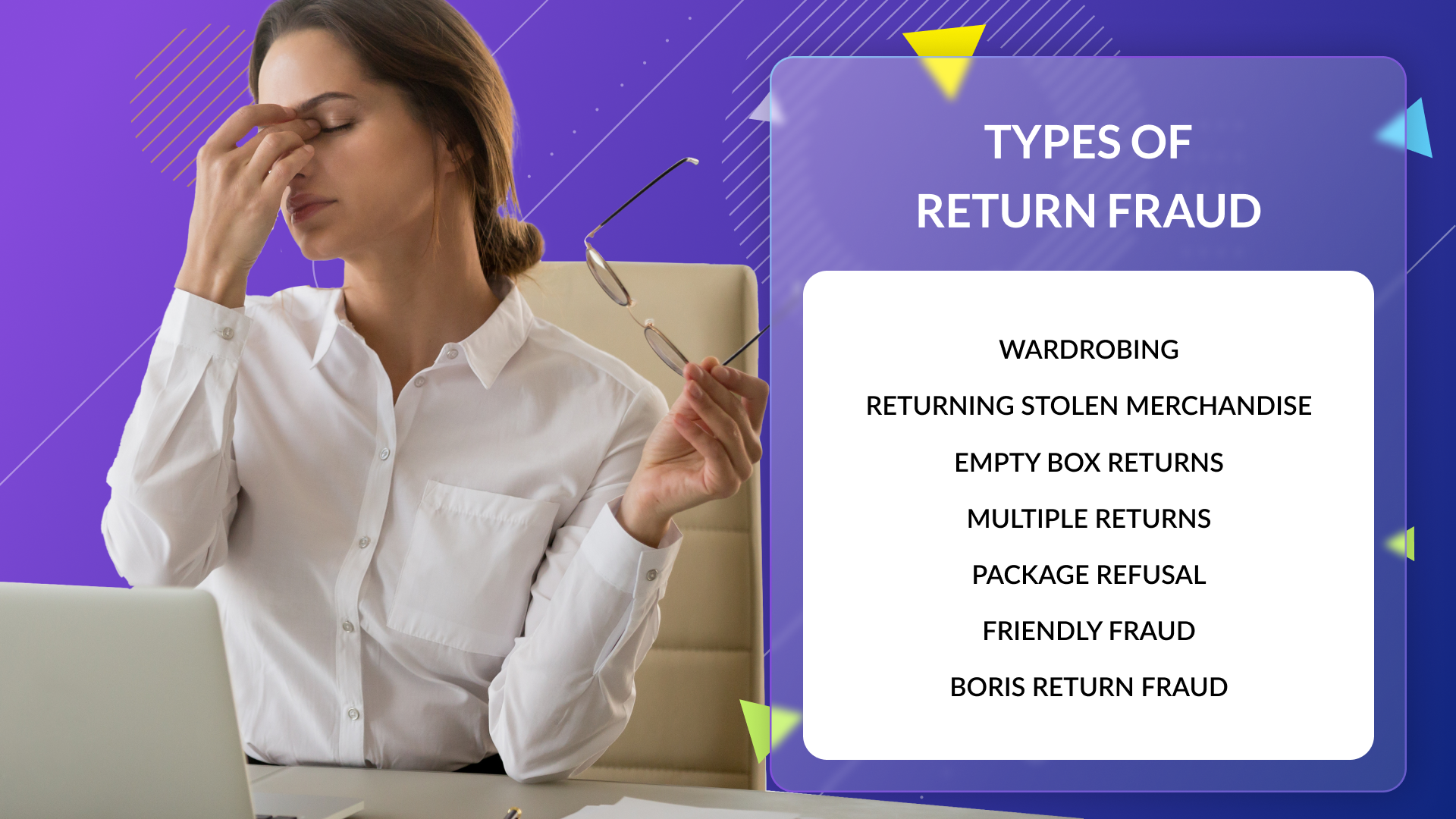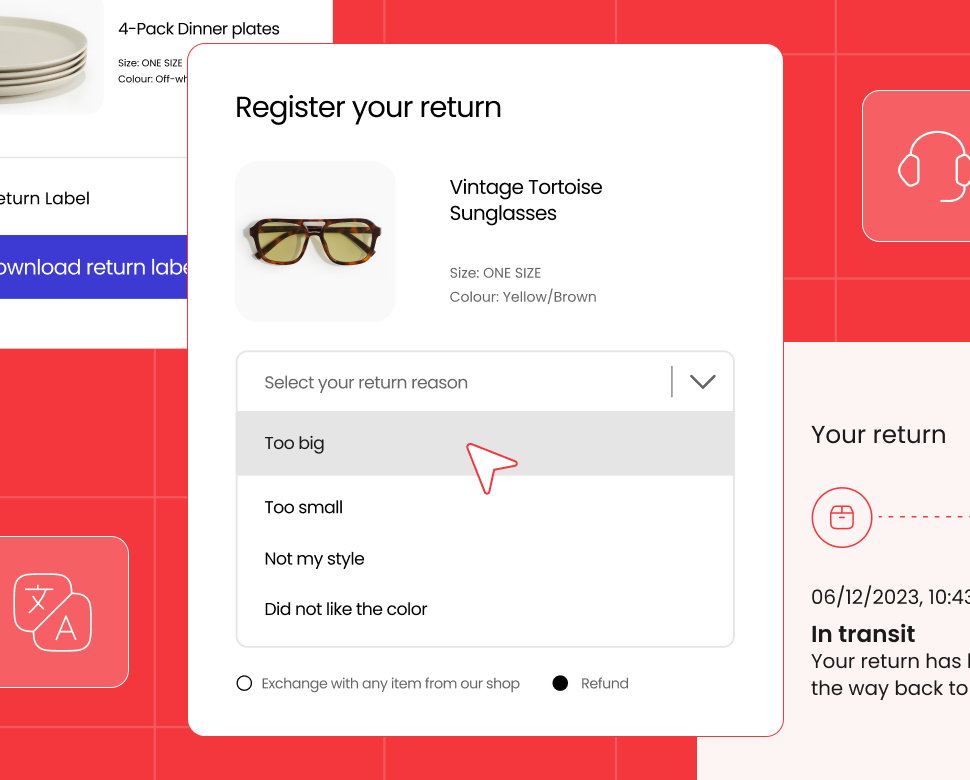How to Prevent Return Fraud

What’s worse than product returns in eCommerce?
Fraudulent returns.
A major headache for retailers everywhere, return fraud makes up $103 billion or 15.14% of total returns in 2024. That’s a significant amount of money being siphoned off retailers, and it highlights the importance of detecting and preventing return fraud. Let’s dive into the murky waters of return fraud and shed light on how you can handle it.
What is online return fraud?
eCommerce return fraud is a deceptive practice where individuals exploit a retailer’s return policy and procedures for (unfair and illegal) personal gain. In many cases, fraudulent returns involve tactics in which individuals procure goods without genuinely purchasing them.
At a broader level, return fraud doesn’t just apply to online retail. Those who commit fraud can do it across multiple channels. For instance, someone may initiate an offline return for a fraudulent online purchase.
Needless to say, return fraud has serious ramifications for retailers. It’s becoming increasingly problematic, particularly with issues like inflation and shrinking profit margins.
The most common types of return fraud
Before getting into preventative steps, it’s worth discussing the different types of return fraud. As with any type of deception or scam, fraudulent returns come in several forms.
Wardrobing
Sometimes referred to as “wear and return,” wardrobing is the practice of purchasing an item, using it once or for a short duration, and then returning it for a full refund, claiming it as unused.
Wardrobing is common in the fashion industry, where customers (or fraudsters, in this case) buy clothing or accessories for an event with the sole intention of returning them afterward.
Retailers that sell electronics and high-end goods are also susceptible to wardrobing, as consumers might purchase gadgets or luxury items for short-term use.
Returning stolen merchandise
Another type of return scam is when a customer returns an item they never purchased from the store. Instead, the product they’re trying to return was acquired through theft or other illicit methods.
Empty box returns
Empty box returns are exactly what they sound like: people purchase something online and initiate a return via mail. Instead of putting the product in the return package, they mail out an empty box and keep the merchandise.
They’ll then claim that they sent the item, and the fault must lie either with the shipping company or the retailer’s receiving department. People who engage in this practice expect a full refund or a replacement while retaining the original product.
Multiple returns
Some fraudsters repeatedly buy and return items to exploit welcome discounts, cashback offers, or other promotional deals.
Package refusal
This is when someone orders a product online and refuses to accept the delivery when it arrives. When the package is returned, the customer typically claims a refund, asserting they never received the item. Whether due to buyer’s remorse, fraudulent intent, or wanting to avoid return shipping fees, package refusals can cause headaches for retailers handling them.
Friendly fraud
Don’t be fooled by its name; friendly fraud is anything but. This is a practice in which the customer makes a purchase using their credit card, receives the product or service, but then disputes the charge with their credit card issuer, claiming it was unauthorized or fraudulent.
This type of fraud is called “friendly” because it comes from what appears to be a legitimate customer rather than a stereotypical criminal or hacker.
Buy online, return in-store (BORIS) return fraud and receipt fraud
Common among those implementing omnichannel returns, BORIS return fraud is a return scam where someone obtains a product through unscrupulous measures and returns that product to the store for a “refund.”
This usually involves receipt fraud, wherein someone tries to initiate multiple returns—using the same online receipt—to get additional refunds.
According to the National Retail Federation, “Fraudsters may be taking advantage of data synchronization delays between point-of-sale and merchant systems, allowing them to use e-receipts for multiple returns in-store. Multichannel retailers may need to consider additional technology solutions to prevent fraudulent return attempts.”
Research from the NRF also found that 12.7% of BORIS returns are fraudulent, saying that “BORIS return fraud is estimated to be 48% higher than returns to non-store locations.”
All of this highlights the importance of having a tightly integrated eCommerce returns management system and ensuring real-time data sync.
Tips for detecting return fraud
Now that we’ve covered the basics of return fraud, let’s discuss how to detect it. Here are some tips you can incorporate into your returns management practices to help protect your business from scams.
Closely examine merchandise
When accepting returns, be sure to thoroughly inspect the items for signs of wear and tear, damage, or tampering. Those who want to get away with wardrobing may try to return used or damaged items as new, or they may remove tags or packaging to conceal the fact that the item has been used.
Tip: Track items that are commonly returned for fraudulent reasons, such as high-value items, clothing, and electronics.
Implement receipt verification
If possible, require your customers to provide a receipt or proof of purchase. Doing so can help deter fraudsters from returning stolen or counterfeit goods.
When checking receipts, verify them against your order database. You can make this step easier using tools like barcode or QR code scanning.
Use a return merchandise authorization (RMA) system
A return merchandise authorization (RMA) system requires customers to obtain approval before initiating a return. This added step allows businesses to track and evaluate return patterns, helping identify and prevent potential fraudulent activities.
Just note that having an RMA adds friction to the ecommerce customer experience (which can frustrate legitimate customers). So, try to balance things out by making other parts of the process as easy and convenient as possible. For example, you could implement return authorization just for high-value items or if a shopper has a history of suspicious activity.
Train your employees to spot return fraud
Educate your employees on the common tactics used by return fraudsters, such as returning stolen or counterfeit items or returning items that have been used or damaged.
For best results, include return fraud training in your employee onboarding process, and consider doing refreshers and follow-up sessions if needed. Here are some things you can cover in your training:
– Give employees information on the most common types of return fraud.
– Show them examples of counterfeit and damaged merchandise.
– Teach them how to verify receipts and identify suspicious return patterns.
– Give them the confidence to report any suspicious activity to their manager.
Best practices for reducing return scams
Any instance of return fraud is too much, so if you’re grappling with return scams in your business, below are some steps you can take to reduce them.
Start with a firm returns policy
Reducing return scams starts with a solid returns policy. When people know that clear-cut rules and consequences are in place, they’re less likely to commit return fraud.
To that end, make sure your returns policy clearly communicates what items are eligible for returns, the time frame for returning products, and any documentation (i.e., proof of purchase and ID) to provide at the point of return.
When your policies are ironed out in black and white, customers understand the boundaries, leading to fewer ambiguities and potential disputes.
Regularly review transaction and chargeback data
We’ve alluded to this earlier, but it’s worth repeating: reviewing data like purchase and returns history can uncover suspicious activity, which then helps you prevent return scams.
Beyond that, consider reviewing chargeback data, as it can provide insights into the types of fraud targeting your business.
For example, if you see many chargebacks for items that are frequently returned, you could consider implementing stricter return policies for those specific products.
When reviewing chargebacks, be sure to:
– Look for patterns in chargeback reasons.
– Identify customers who have a history of chargebacks.
– Track chargebacks by product category or region.
– Compare your chargeback rate to industry benchmarks.
– Use chargeback data to inform your fraud prevention strategy.
– Keep your systems tightly integrated
It’s much harder to spot and prevent return scams and fraud when you don’t have accurate and up-to-date data across your ecommerce tech stack. As mentioned earlier, fraudsters can take advantage of data lags to return items multiple times.

You can prevent this by ensuring that your business platforms are tightly integrated. Make sure your returns management solution seamlessly connects with your:
– eCommerce platform
– Inventory management system
– Customer relationship management (CRM) system
– Payment processing system
– Fraud detection software
That way, you have real-time updates and comprehensive oversight of product returns.
What to do when you encounter return fraud
Prevention is the best way to deal with eCommerce fraud. But in the event that it does occur, there are some steps you can take to address it.
Dispute chargebacks
If you encounter fraud involving chargebacks, file a dispute with your payment processor.
Gather evidence to support your claim, such as proof of purchase, tracking information, and photos of the returned item. It also helps to present your return policy if someone initiates a chargeback that violates your terms.
Restrict or ban chronic returners
If you identify a customer who is returning an excessive number of items, you may want to restrict or ban them from returning items in the future. This can be done by adding them to a blacklist or limiting the number of returns they are allowed to make in a given period.
Report fraud or pursue legal action
Depending on the situation, you may need to report fraud to the appropriate authorities and investigative agencies.
You could also consider pursuing legal action against fraudsters. This is usually a last resort, as trying to prosecute someone can take a lot of time and money. As such, you should only consider this if the fraud is significant and justifies the resources you’ll spend on legal fees.
Final words
Return fraud isn’t just a hassle for eCommerce businesses; it’s a severe issue that can cause wasted time and financial losses. The best way to “deal with” return fraud is to prevent it from happening in the first place, so make sure you have solid policies and practices in place.
In addition to enforcing your returns policy, regularly review sales and returns data. It’s also helpful to equip employees with the knowledge and tools to prevent return scams.
Finally, it’s vital to have tightly integrated solutions to keep your data synced and updated.



